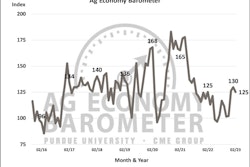
The latest USDA World Agriculture Supply and Demand Estimates for March calls for lower exports and larger ending stocks for U.S. corn.
Exports are reduced by 75 million bushels to reflect the slow pace of sales and shipments this year despite relatively competitive U.S. prices.
With no other changes from February, ending stocks rose by 75 million bushels. The season-average corn price dropped a dime to $6.60 a bushel.
WHEAT: The 2022/23 U.S. wheat supply and demand outlook is unchanged from last month.
- The projected season-average farm price remains $9/bushel.
The 2022/23 global outlook this month is for slightly smaller supplies, increased trade and consumption, and lower ending stocks.
Supplies are lowered slightly as an increase in production nearly offsets a decrease in beginning stocks, which are lowered mostly on an increase for China 2020/21 feed and residual use. This reduction is based on an updated analysis of government old-crop wheat stocks auction data. Nearly offsetting this change, global production is raised 5.1 million tons to 788.9 million primarily on increases for Kazakhstan, Australia and India.
Production estimates for all three countries are raised on updated government data. Wheat production in Kazakhstan is now forecast at 16.4 million tons, 2.4 million higher than last month, and the largest harvest since 2011/12. World trade is raised 1.0 million tons to 213.9 million as increases for Kazakhstan, Australia, and Brazil more than offset decreases for Argentina and India.
Global use is forecast 2.0 million tons higher to 793.2 million, largely on increases in India food, seed, and industrial use and Kazakhstan feed and residual use. Global ending stocks are lowered 2.1 million tons to 267.2 million, as smaller stocks for China more than offset increases for Argentina, Kazakhstan, and Australia.
COARSE GRAINS: This month’s 2022/23 U.S. corn outlook is for lower exports and larger ending stocks. Exports are reduced 75 million bushels reflecting the poor pace of sales and shipments to date despite relatively competitive U.S. prices. With no other use changes, ending stocks are up 75 million bushels from last month.
- The season-average corn price received by producers is lowered 10 cents to $6.60/bushel based on reported prices to date.
Global coarse grain production for 2022/23 is forecast 3.2 million tons lower to 1,439.6 million. This month’s foreign coarse grain outlook is for reduced production, consumption, and ending stocks relative to last month. Foreign corn production is down, with a decline for Argentina partially offset by increases for India and Paraguay.
For Argentina, production is cut as continued heat and dryness during February and into early March reduce yield prospects for late-planted corn. India corn production is higher based on official government data. Foreign barley production is higher reflecting increases for Kazakhstan, Australia, and Argentina. Foreign sorghum production is lowered with declines for Australia and Argentina.
Major global trade changes for 2022/23 include higher projected corn exports for India, Ukraine, and Paraguay, with reductions for Argentina and the U.S.
Corn imports are lowered for Turkey, Iran, Malaysia, Chile, Colombia, Egypt, Morocco, Peru, and Taiwan. Sorghum imports are lowered for China based on export cuts for Australia and Argentina. Foreign corn ending stocks are down relative to last month, reflecting declines for Ukraine and Brazil that are partly offset by an increase for India. Global corn ending stocks, at 296.5 million tons, are up 1.2 million.
OILSEEDS: U.S. soybean supply and use changes for 2022/23 include higher exports, lower crush, and reduced ending stocks compared with last month’s report. Soybean exports are raised 25 million bushels to 2.02 billion based on higher-than-expected shipments through February. Soybean crush is reduced on a small reduction in domestic soybean meal disappearance combined with a higher extraction rate. With higher exports more than offsetting lower crush, ending stocks are reduced 15 million bushels to 210 million. If realized, ending stocks would be the lowest in seven years.
With relatively strong domestic demand for soybean oil limiting export competitiveness, U.S. soybean oil exports are reduced 200 million pounds to a historically low 500 million. Higher domestic use and reduced production are offsetting, leaving soybean oil stocks unchanged this month.
- The U.S. season-average soybean price forecast for 2022/23 is unchanged at $14.30/bushel.
- The soybean meal price is forecast at $465/short ton, up $15.
- The soybean oil price is reduced 2 cents to 66 cents/pound.
Global 2022/23 oilseed supply and demand forecasts include lower production, crush, and stocks. Global oilseed production is reduced 6.8 million tons to 629.9 million, mainly on lower soybean and sunflowerseed production for Argentina partly offset by higher Australia rapeseed production. Soybean production for Argentina is lowered 8.0 million tons to 33.0 million on dry and hot weather conditions. Uruguay soybean production is also lowered 0.2 million tons to 2.1 million. Australia rapeseed production is increased 1.0 million tons to 8.3 million on higher area and yield.
Global oilseed trade is up 1.9 million tons to 199.9 million on higher rapeseed and soybean exports. Rapeseed exports are increased for Australia and Ukraine, in line with higher imports for the EU and Pakistan. Soybean exports are higher for Brazil and the U.S., and imports are higher for Argentina to partly offset production losses. Soybean imports are also raised for Iran and Turkey.
Global 2022/23 oilseed crush is lowered 3.3 million tons to 526.3 million, mainly on a slower-than-expected soybean crush pace for China and lower available soybean and sunflowerseed supplies for Argentina. Lower Argentina vegetable oil exports are offset by higher shipments of palm oil from Malaysia and sunflowerseed oil from Turkey, Russia, and Ukraine.
Global soybean ending stocks are lowered 2.0 million tons to 100.0 million, with lower stocks for Argentina, Brazil, and the U.S. that are partly offset by higher stocks for China.
















